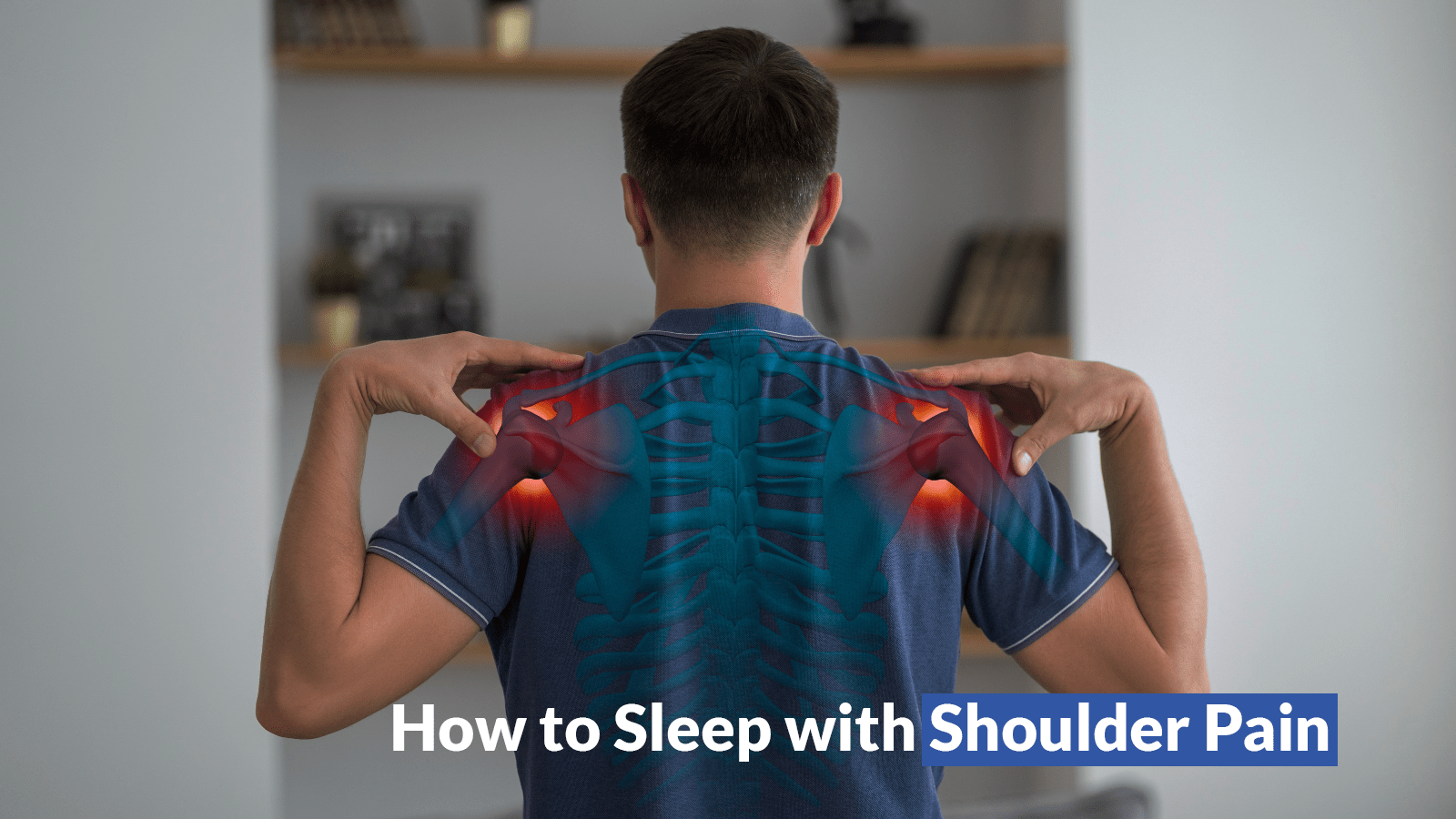Ever dream of a night free from that persistent shoulder ache? A whopping 26% of us battle a prickly shoulder at some point, and guess what suffers most? Sleep! Tossing and turning like a ship in a storm is no fun, which is why we’re here to figure out how to sleep with shoulder pain.
Forget counting sheep – we’re counting causes! From overuse aches to misaligned rotator cuffs, there’s a whole posse of culprits behind shoulder issues. But worry not, by understanding the most common causes of shoulder pain, implementing pro tips, learning the best sleeping positions and exploring treatment methods like osteopathy and ergonomics, you can find relief and get back to pain-free sleep. This complete guide equips you with everything you need to conquer shoulder issues.
The Complex Reasons Behind Shoulder Pain
We’ve all desperately reached behind our backs trying to scratch that unreachable itch, only to wince in shoulder pain. Or spent restless night after night trying to find relief from persistent shoulder aches. But what causes these all-too-common shoulder issues that disrupt our sleep and daily lives? The root lies in the complicated structure of the shoulder joint. This remarkable anatomy, making our arms move smoothly, relies on the seamless teamwork of several parts.
The glenohumeral joint enables movement, rotator cuff muscles provide stability, bursae cushion impacts, and the labrum keeps everything aligned. When any of these parts become injured, inflamed or degraded over time, they protest by triggering pain signals. Then limitations in movement emerge, making scratching that annoying itch or getting comfortable in bed suddenly feel impossible. By understanding the shoulder’s anatomy and caring for it properly, we can ease the aching joint to enjoy restful nights again!
Most Common Causes of Shoulder Pain
Learning about how your shoulders function helps figure out what makes them hurt. Some common contributing factors to shoulder pain include:
Rotator Cuff Injury
Using your shoulder a lot, ageing, accidents, or athletic moves can stretch or tear the muscles and tendons in your rotator cuff. You might feel pain when lifting your arm, along with weakness, sensations like it’s catching, and difficulty moving it around.
Bursitis
Little cushions around your joints, called bursae, help things glide smoothly. But if you lean too much, or do the same movement over and over, they can get inflamed and grumpy, which results in bursae puffing up like overfilled balloons. This swelling creates that tender, achy feeling – like someone’s pinching you from the inside!
Arthritis
Arthritis can develop when joints get sore and stiff from giving your body the robot treatment, doing the same movements over and over. Joints use soft cushions called cartilage to move smoothly. But repetitive strain on your joints can wear down these cushions, leading to arthritis. To maintain your joints’ health, be careful with repetitive activities.
Adhesive Capsulitis
Your shoulder joint has a protective sleeve called the capsule. When this sleeve gets inflamed, it swells up and tightens, making your arm feel like it’s stuck in a rusty hinge. We call this a “frozen shoulder,” and some conditions like diabetes and thyroid can make it more likely to happen.
Labral Tears
Similar to knee injuries, the labrum cartilage can detach from bone after falls or dislocations causing instability, clicking, locking, and pain.
Referred Pain
Shoulder pain can sometimes originate from areas beyond the joint itself, such as pinched nerves, and issues in the spine, lungs, or other organs. However, pain originating within the shoulder joint is also common. The specific location and accompanying symptoms often help differentiate the cause.
Best Sleeping Positions for Shoulder Pain
Getting comfortable enough to sleep soundly can feel impossible when shoulder pain strikes. But your sleeping position plays a major role in how much additional strain aggravates injury sites and how well you support affected tissues overnight. Ultimately, this determines whether you wake up feeling refreshed or in agony.
Follow these expert tips on how to position an ailing shoulder to avoid extra pressure while cushioning it just right:
Back Sleepers
Relieve painful shoulders by placing a slim pillow securely under the shoulder blade of the affected side. This keeps the joint neutrally aligned, preventing it from dropping down into the mattress. Support proper spinal alignment by putting another pillow under the head and neck.
Unaffected Side Sleepers
Lay on your non-painful side and slip a supportive pillow snugly between the knees and lower legs. This prevents the sore shoulder from rolling too far forward while you sleep. Again, support the head and neck.
Stomach Sleepers
Put a slim pillow under the midsection to gently raise the sore shoulder off contact with the bed. This avoids direct compression that can cause persistent aches. Support your head/neck with another pillow stack.
Tips for Pain-Free Sleep
Beyond choosing the right sleeping posture, simple adjustments to your nighttime routine and sleeping area can meaningfully reduce shoulder pain for high-quality sleep. Follow these expert tips:
1- Avoid Sleeping on Your Painful Shoulder
Never sleep with direct pressure on an actively inflamed or injured shoulder. This worsens the damage.
2- Use a Soft Mattress and Pillow
Select a soft mattress and pillow made from contouring materials. Hard surfaces often amplify pain points.
3- Apply Ice or Heat to Your Shoulder Before Bed
Apply ice packs or heating pads for 15-20 minutes before bed to reduce inflammation or relax the shoulder. Always wrap them to protect your skin.
4- Take Over-the-counter Pain Relievers
Take ibuprofen, acetaminophen, or your doctor-approved oral medication in the evening as needed to temporarily reduce inflammation for sleep.
5- Consult Your Doctor or Physical Therapist
See your physician if pain severely disrupts your nightly rest and daily routines for over 2 weeks. Diagnosis is key for proper treatment.
How Osteopathy and Ergonomics Can Help You Sleep with Shoulder Pain
For lasting shoulder pain relief and functional improvements, address underlying mechanical triggers with osteopathy and ergonomics. These holistic sciences treat root issues rather than just managing symptoms.
Osteopathy for Shoulder Pain
Osteopathy is a holistic approach to health that emphasises the relationship between the structure and function of the human body. Osteopaths use manual techniques like joint manipulation and massage to treat musculoskeletal conditions. It can help you sleep with shoulder pain by:
Reducing the pain and inflammation in your shoulder
Osteopaths use soft pushing, rubbing, and a little shake to stimulate blood flow and fluid drainage to alleviate inflammation. This can make your shoulder feel less painful and swollen.
Restoring the mobility and range of motion in your shoulder
Osteopaths use hands-on tricks, like gentle moves and stretches, which help mobilise stiff joints and loosen contracted muscles/tendons to restore mobility. This helps your shoulder move better and not feel so stiff.
Correcting the alignment and posture of your shoulder
They can use manipulation, stretching, and mobilization to realign bones, joints, and tissues to correct posture and mechanics. This can help correct the alignment and posture of your shoulder and prevent further injury or pain.
Improving the function and coordination of your shoulder
Osteopaths can use manipulation, stretching, and mobilisation which results in improving nerve communication between the shoulder complex and the body for better coordination and performance.
Ergonomics For Shoulder Pain
Ergonomics is a scientific discipline that studies how human beings interact with their work setting. It also focuses on how to design a work environment to support their well-being and productivity. Ergonomists analyse work environments and processes to recommend equipment enhancements and workflow adjustments. This can help you sleep with shoulder pain by:
Reducing the stress and strain on your shoulder
Ergonomists can help you organise your work setup, such as your desk, chair, and locker space, This helps reduce repetitive strain and overuse of the shoulders.
Promoting the comfort and support of your shoulder
Ergonomists can help you choose assistive devices like supportive chair pads, wrist rests and adapted keyboards/mice. Doing so can provide more comfort and support for your shoulder and prevent pain, stiffness, or discomfort.
Enhancing the efficiency and accuracy of your shoulder
Ergonomists can help you with optimising your work processes such as deadlines, goals, and breaks to avoid fatigue, errors, and injury from overworking shoulders
Get Customised Treatment from the Experts at Osteopath Sydney
To improve shoulder function during daily and nightly activities through osteopathy, ergonomic changes, exercise, medication, or surgery, make an appointment with the seasoned practitioners at Osteopath Sydney.
Their holistic assessments detect the unique root cause of your shoulder pain. Then, they craft tailored treatment plans using precise modalities to meet your needs whether you want conservative care or fast-acting interventions like injections.
Final Thoughts
Shoulder pain, whether arising from malpositioning during sleep or dealing with discomfort on both sides, poses a considerable challenge with implications for sleep quality and overall health. Nonetheless, understanding the underlying causes of these discomforts is the first step to getting back to quality sleep.
In addition to that, choosing the best sleeping positions for shoulder pain, and following some tips for pain-free sleep, can boost your sleep quality and shoulder health, providing relief for those struggling with sleeping on shoulder pain.
Need a bit more help? Osteopathy and ergonomics are your saviours! They can tackle the core causes of your shoulder pain, getting your arm back in tip-top shape and feeling good again. If guidance on how to sleep with shoulder pain on both sides is what you’re after, Osteopath Sydney’s experts are a phone call away!


